Anyone can make a great video.
You can whip out your phone, hit record, and tell a great story in a few minutes.While you can do it a few times and get some engagement, you're relying on yourself to come up with the ideas constantly, which eventually will lead to burnout and won't translate in additional sales for your products.
That's where a video strategy comes into place.
The idea is to understand your customer psychology so you never have to guess again what type of content to create, and you'll ultimately, you can make your product launch a success.
In this blog post, you’ll learn how to create a killer video strategy to drive sales of your SaaS products in 2023. You’ll learn how to:
- Identify and map your audience Buyer’s Journey
- Choose the right types of channels for each stage of the journey
- Create promo videos that create curiosity
- Create explainer videos that educate leads
- Create testimonial videos that boost credibility
- Create support videos that retain customers
- Measure and optimize your video marketing performance
By the end of this blog post, you’ll have a clear roadmap for creating videos that will help you crush your product launch.
Let’s get started!
Why is video important for marketing?
Let me show you some stats:

- More than half of consumers want to see more video content from brands they support. - HubSpot
- Eight out of ten people say that watching a video has convinced them to buy a software product or service. - Wyzowl
- Nine out of ten businesses say they’ve gained a new customer as a result of posting a video on social media. - Animoto
But why is video so powerful?
Video taps into a basic human instinct: listening to stories. Stories are how we perceive the world, how we learn from others, how we form emotional bonds.
And video is the best way to tell stories.
According to Tyler Lessard and Marcus Sheridan in their book, The Visual Sale, video has four superpowers:
- Video is educational: It’s faster to process and easier to remember than text or audio.
- Video is engaging: It enables us to tell stories and hold audience attention.
- Video is emotional: It can invoke joy, anticipation, trust and other emotions that influence decision-making.
- Video shows empathy: It helps us relate and connect on a human level.
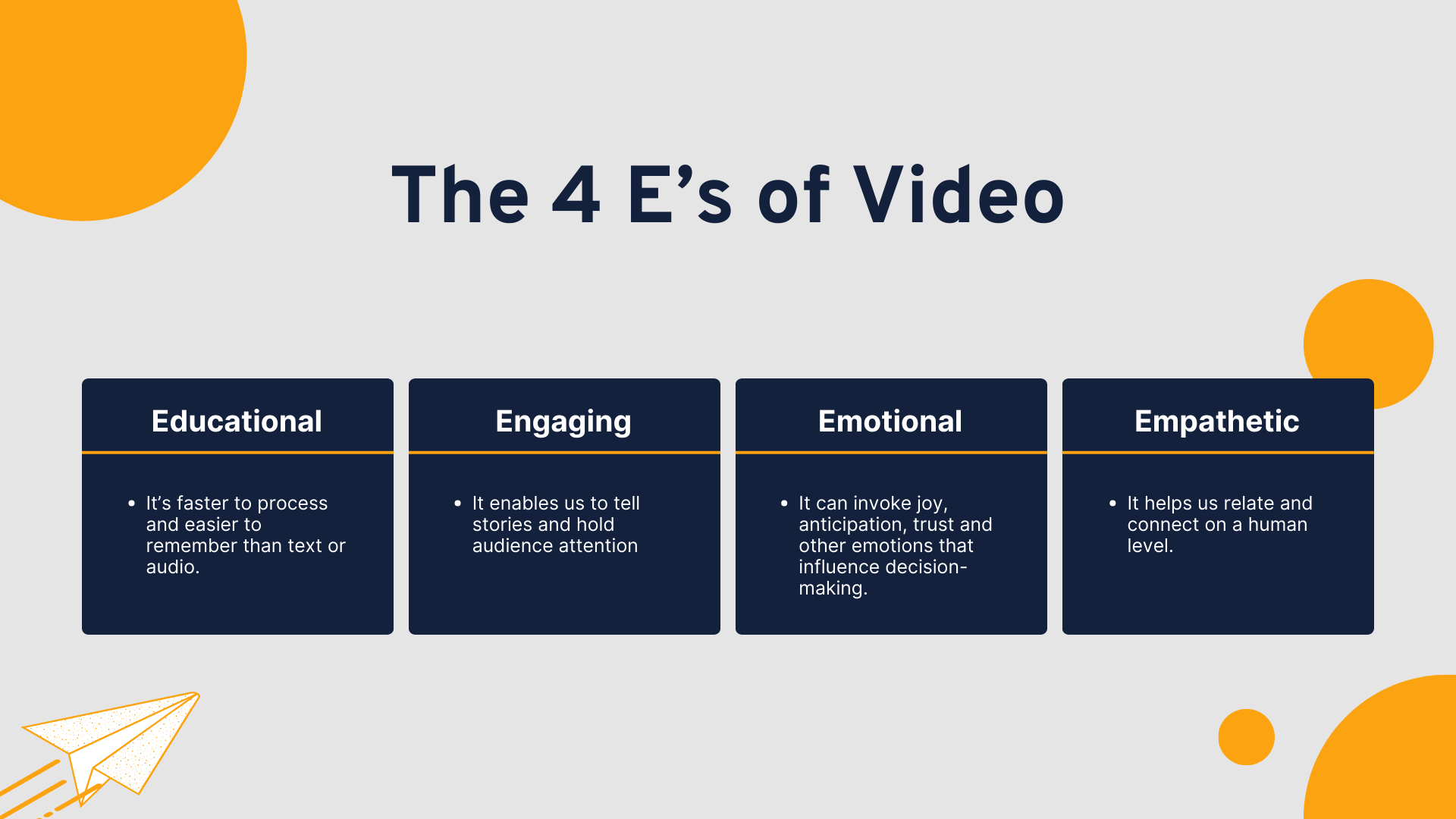
Now that sounds like a great marketing tool.
However, there's a few misconceptions about creating videos that you might have heard of, and that we need to get out of the way today.
Myths about Video Marketing
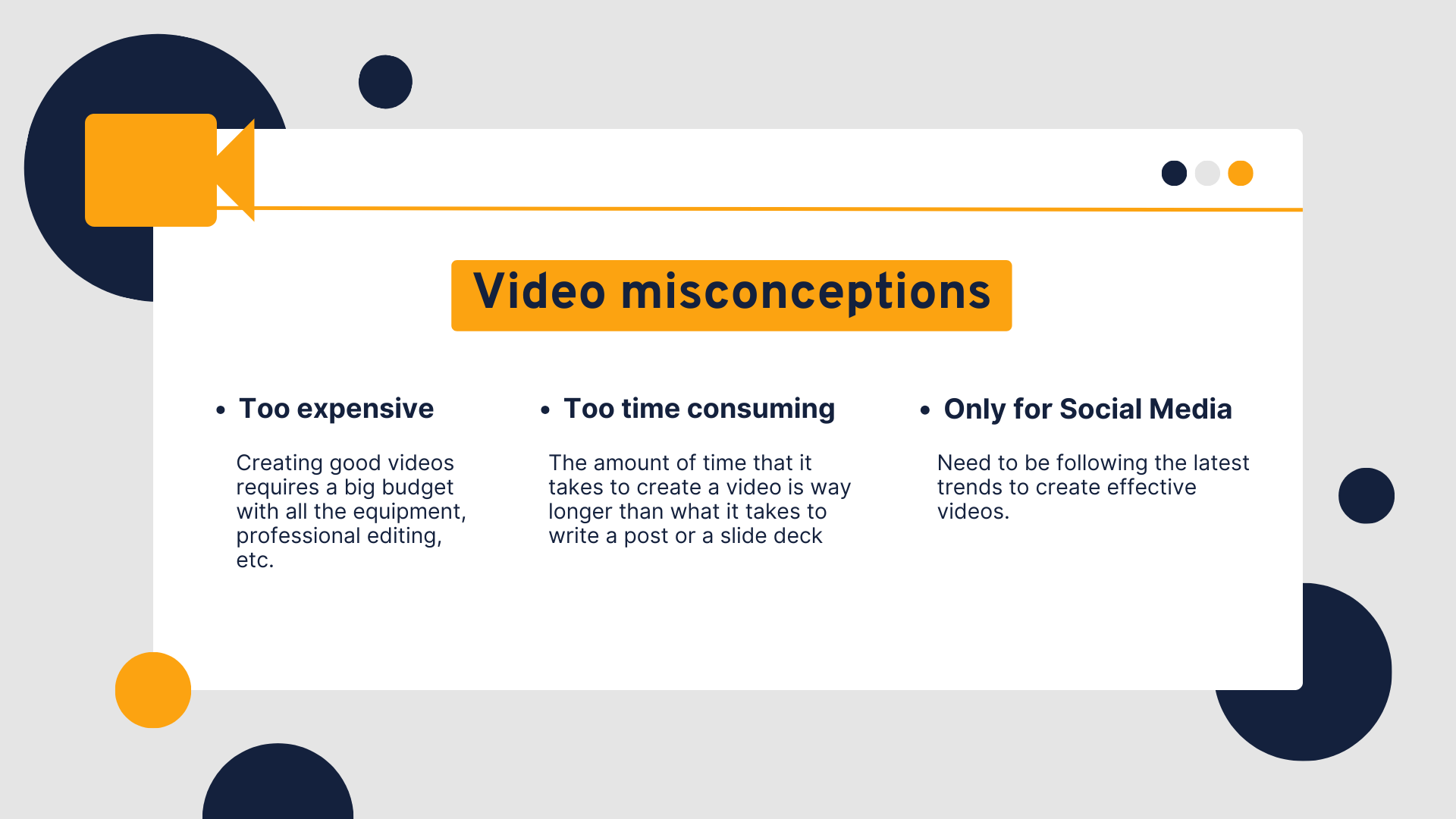
Myth #1: Video is too expensive.
Typically, people think that creating good videos requires a big budget with all the equipment, professional editing, etc.
If this sounds familiar, then I want to show some examples that Vidyard has collected about has helped other marketers and sales professionals achieve their goals faster with videos they created on their own.
Yes, there’s a place for videos that look awesome and super polished.
But the main goal, especially when launching a product, is to build trust.
Through video, a prospect may hear from a marketer they met at an event, or directly connect with a sales rep, taking your enablement to a whole new level.
Myth #2: Video marketing is too time-consuming.
True, the amount of time that it takes me to create a video is way longer than what it would’ve taken me to write a post or a slide deck.
But if the videos are able to build trust with your audience, and reduce their perceived risk of your product, then it’s worth it.
You can easily repurpose your existing product narrative as a video script as a starting point.
Myth #3: Video marketing is only for social media.
Depending on your product, there's a lot of other places to put your launch videos that will be even more effective: including your website, e-mail campaigns, product, or events.
So with these misconceptions out of the way, there’s no excuse to start building videos for your launch.
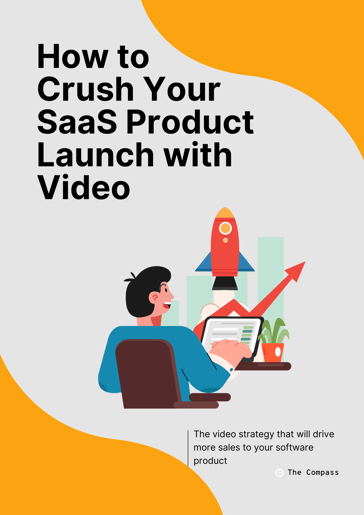
FREE Guide
If you want to have the information from this post handy, download our guide: How to Crush Your SaaS Product Launch with Video. It has all of the tips and strategies you need to create a successful launch.
Get the Free Guide
Now that we know why videos are key, let’s dive in.
The Buyer's Journey for Video
The truth is that you need to show your videos to the people who are going to see most value from them.
Depending on how familiar they’re with your brand, they will need different information to as they journey from strangers to buyers.
The buyers’ journey is a map of actions a consumer makes before they buy from you. Understanding it is key, because it gives you access to your users’ psychology.
Traditionally, it’s made up of three stages. I’ll be using an example of a productivity app:
- Awareness stage: The buyer is experiencing a problem but doesn’t know how to solve it. They aren’t familiar with your product yet. Maybe they’re an executive who is looking to have a better work life balance.
- Consideration stage: The buyer is clear in their problem and is looking for potential solutions. They might be familiar with your brand. At this point they’re thiking whether to do journaling in a physical one, buy a calendar, or maybe a productivity app.
- Decision stage: The buyer has chosen their type of solution and is ready to make a purchase. They know your brand, but may not fully trust it. They’re looking at you and your competitors.
As you can see the information people need to make these decisions is totally different.
By mapping your buyer’s journey, you’ll be able to create videos that match each stage of the journey and guide your leads towards becoming customers.
There’s also a fourth stage that comes after the purchase:
- Post-sale stage: The buyer has become a customer and is using your product. They are looking for support content that helps them get the most out of their purchase, and feel confident in their decision.
This stage is often overlooked by marketers, but it can be a massive way for increasing customer retention and reviews, especially at the early stages of the launch.
Now that we know the different stages of the journey, let’s take a look at the channels to place the videos.
How to Choose the Right Types of Channels for Video
Choosing the right channels to distribute your videos is crucial because it helps you reach your target audience at the right stage of the customer journey, giving them information they need at the right time.
Here are some of the most popular channels for each stage:
Awareness Stage
Social Media: This channel will reach a huge audience, though most of them won’t know your product. That’s why clarity and consistency are key.
Keep in mind the following:
- Quality: The quality of the content can vary a lot from simple smartphone videos, screen recordings, to more polished animations.
- Length: Shorter than 1 min videos are preferred to appeal to a new audience, although platforms now allow you to go longer.
- Format: Most social media channels prefer vertical style content, but if you’re doing screen recordings of your products or posting longer youtube videos, then horizontal is preferred.
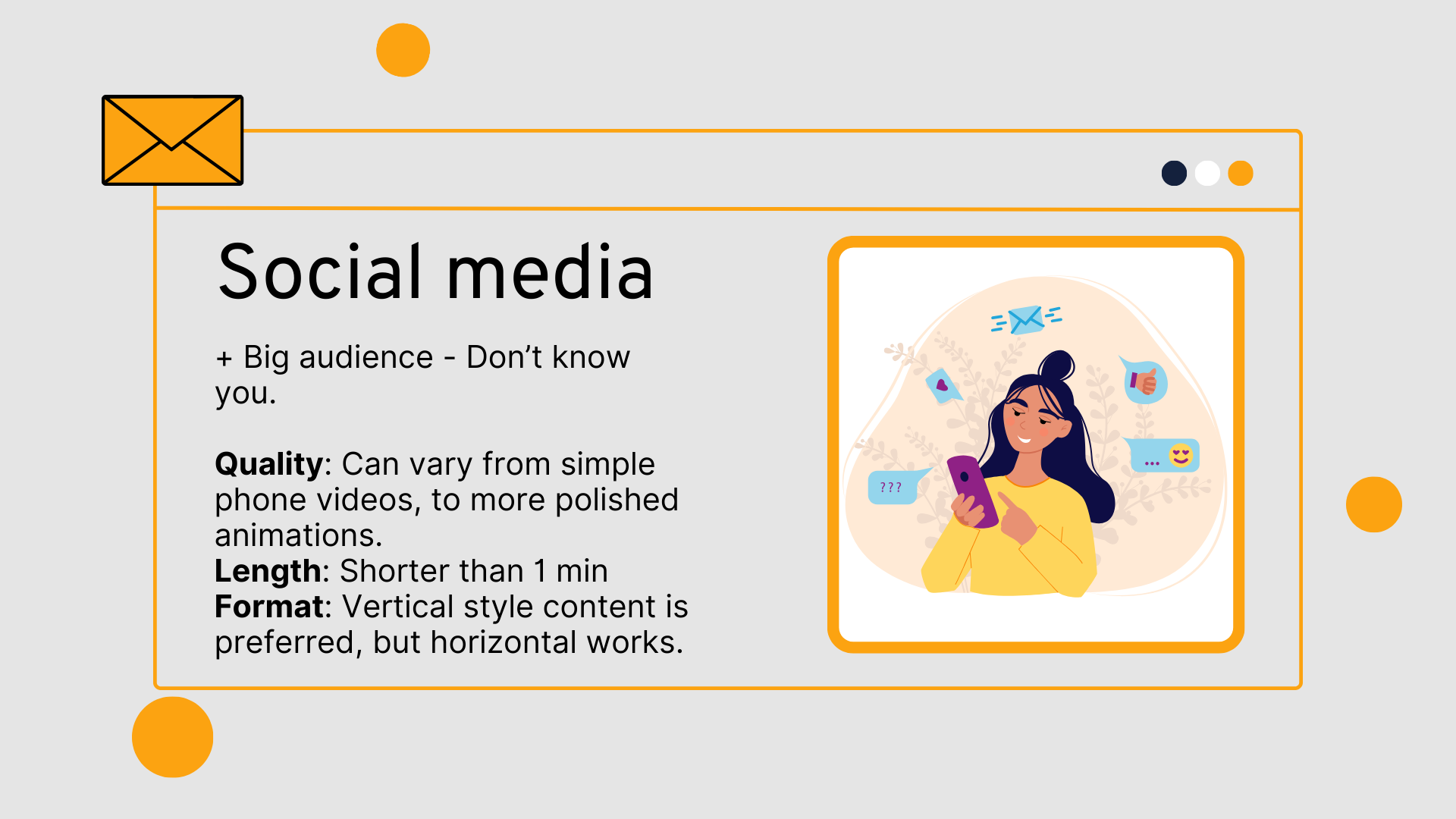
Blogs: Using videos in your blog posts will attract more visitors to your website. Consider the following factors:
- Purpose: Select blog posts that are in line with your product offering and can help generate demand for the product.
- Placement: Place your videos early on in your blog posts, to increase website retention.
- Length: According to HubSpot, the optimal length for a blog post video is between 2 minutes and 6 minutes5. Make sure it doesn’t distract from the blog post topic, or it’s overly promoting your product.
- Optimization: Optimize your videos for SEO and user experience in your blog posts, as they can affect your ranking and readability. use keywords, captions, transcripts, and schema markup for your videos, as well as embed them from platforms like YouTube or Vimeo that offer fast loading and responsive design6.
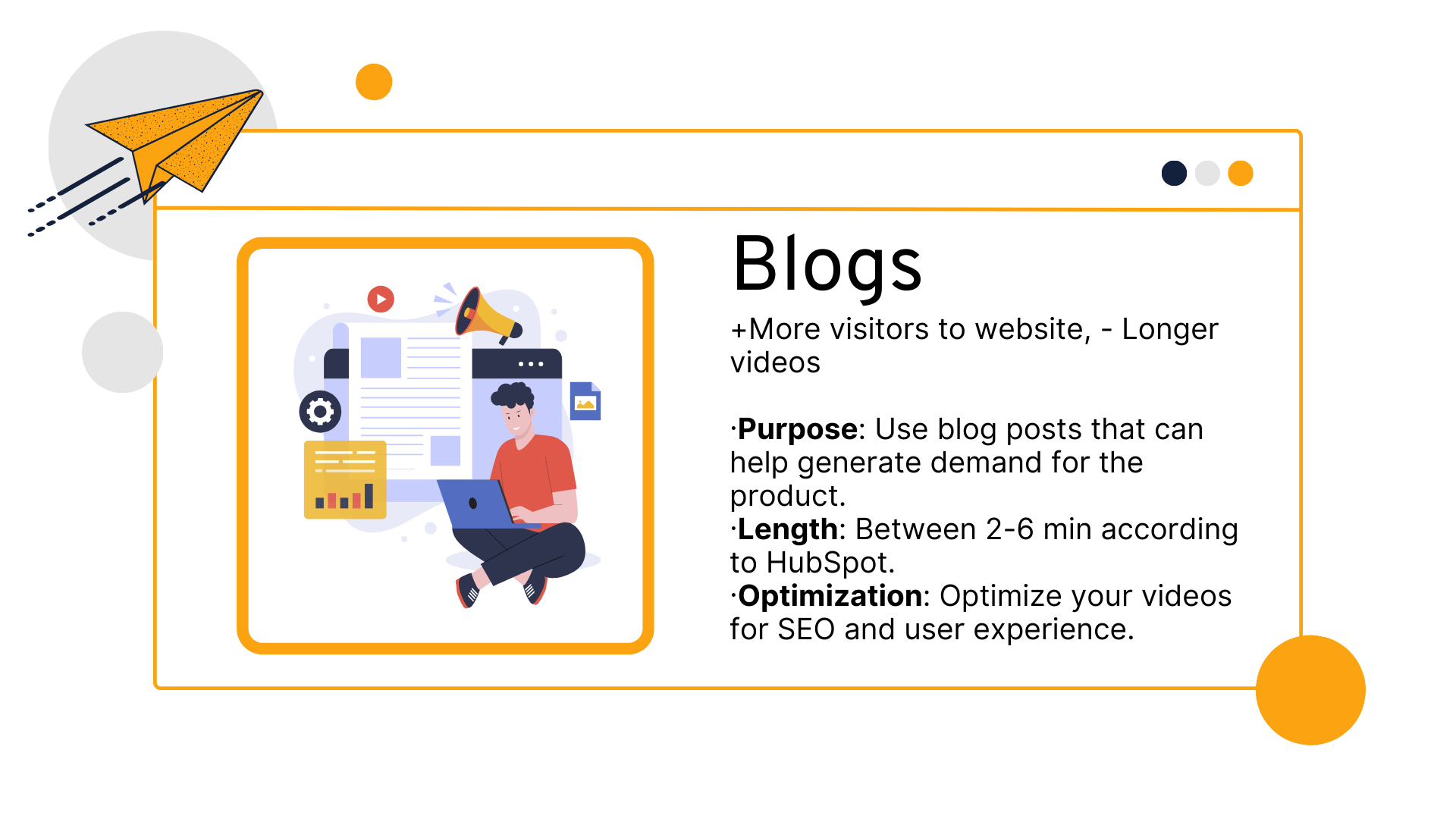
Consideration/Decision
Website: This channel is suitable to show your software in action and explain how it works. Consider the following factors:
- Placement: You should place your videos prominently on your website. For example, you can use a video on your homepage to introduce your business, and then a product specific video on a product page to educate customers.
- Length: You should keep your videos short and sweet on your website, as most visitors have a short attention span and won’t watch long videos. According to Wistia, the optimal length for a website video is between 30 seconds and 2 minutes1.
- Quality: You should ensure that your videos are high-quality and professional on your website, as they reflect your brand image and credibility – especially when customers are considering 2 different brands.
- Optimization: You should optimize your videos for SEO and performance on your website, as they can affect your ranking and loading speed.

Emails: A great channel to increase conversions with current leads, especially since they’re familiar with your brand. Consider the following factors:
- Format: You can’t attach videos to an email, but you can use animated GIFs, thumbnails with play buttons, or links to landing pages with videos2. Make sure it they grab attention.
- Length: Keep your videos short and concise in your email campaigns if they’re personalized, or you can link to a longer webinar if it’s for general info.
- Relevance: You should ensure that your videos are relevant in your campaigns. The copy in the email and thumbnails are the most important part.
- Personalization: For your key accounts, personalized videos can increase the connection and trust with your recipients.
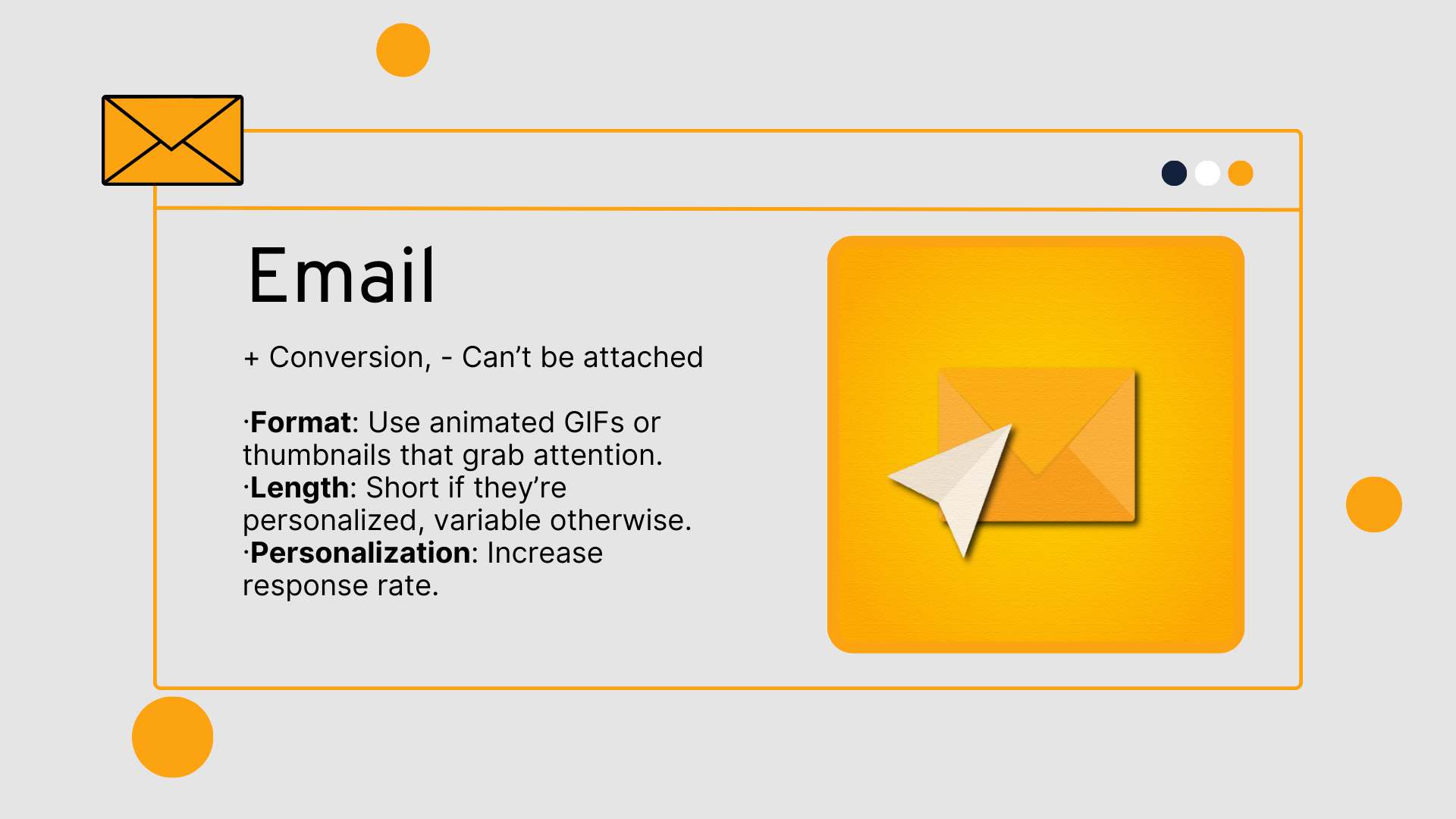
Well that was a lot, but now, you understand the mindset in which your customers are, and how to reach them.
By choosing the right types of videos and channels for each stage of the journey, you’ll be able to create a video marketing strategy that reaches your target audience effectively and efficiently.
4 Types of Videos for Product Launches
Promo videos that capture attention
A promo video is a short and catchy video that introduces your software business to new audiences, builds curiosity, and drives action.
It is ideal for the awareness stage of the buyer’s journey, where you want to capture the attention of potential customers who are looking for solutions to their problems or opportunities.
But how do you create a promo video that works for your software business?
Here are some best practices that you should follow:
- Keep it short: A good promo video should be no longer than 30 seconds or even less to match the average attention span of viewers. You want to deliver your message before they lose interest or scroll away.
- Focus on visuals: Many viewers watch the videos without sound, so use eye-catching images, graphics, animations, colors that convey your brand identity and message.
- Highlight a single problem: You only got a few secs, so use emotional triggers like fear, frustration, joy, excitement, etc. to connect with viewers instantly.
- End with a call to action: Tell viewers what to do next. Whether it’s to follow you, click on a landing page, or register for a livestream, make sure your call to action is visible and easy to follow.
By following these best practices, you’ll create some banger promo videos that will boost your software business in 2023.
Create Explainer Videos That Educate Leads
The second type of video that you need is an explainer video. An explainer video is a short and informative video that explains how your software works and why it’s valuable.
An explainer video is ideal for the consideration stage of the buyer’s journey, where you want to educate your potential customers about your software and how it can solve their problems or help them achieve their goals.
Here are some best practices that you should follow:
- Keep it simple: An explainer video should be no longer than 90 seconds to avoid overwhelming viewers. You should deliver only the essential information, the rest they can find in a PDF or browsing through your site. For example, you can use the following formula to structure your explainer video: Problem + Solution + Benefits + Call to action.
- Focus on benefits: Focus on the benefits rather than on the features of your software. You should show how your software solves your customers’ pain points or helps them achieve their goals.
- End with a call to action: Whether it’s to sign up for a free trial, download a lead magnet, or book a demo, make sure your call to action is visible and easy to follow.

By following these best practices, you’ll create some awesome explainer videos that will grow your software business in 2023.
Create Testimonial Videos That Boost Credibility
A testimonial video features your happy customers sharing their success stories with your software.
It is ideal for the decision stage of the buyer’s journey, where you want to boost your credibility and trustworthiness with your potential customers and persuade them to buy from you.
Here are some best practices to follow:
- Capture authentic stories: A testimonial video should show real customers telling their own stories in their own words, and be specific to their industry. Choose customers that match your target audience, so that your prospects can relate to them.
- Provide a transformation for the audience: A testimonial video should show how your software has changed your customers’ lives for the better, and present the before and after situation. Include before and after stats or pictures. For example, you can show how your software has increased their revenue, reduced their costs, saved their time, or improved their quality of life.
- Focus on the customer and not on your brand: Make the customer the hero of the story, and not your brand. Don't try to overpromote the software or it can come across as fake.
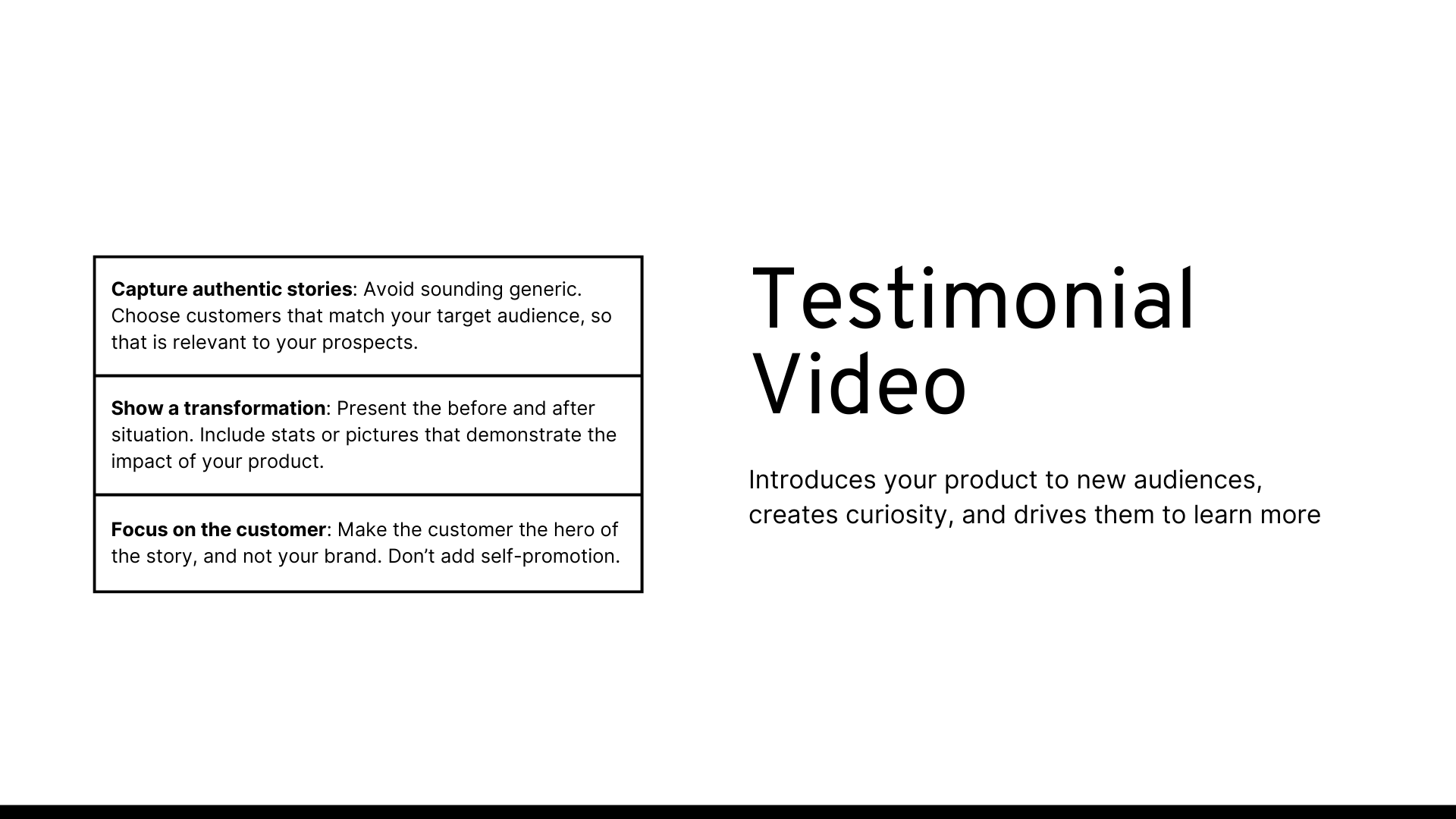
By following these best practices, you’ll create some awesome testimonial videos that will boost your software business in 2023.
Create Support Videos That Retain Customers
A support video teaches your customers how to use your software effectively by focusing on the software features (finally!)
It's ideal for the post-sale stage of the buyer’s journey, where you want to help customers see most value from your product and stay with your company.
Here are some best practices:
- Provide clear instructions: These videos should have a single objective and show your user how to do something specific with your software. Break down the task into smaller steps and use tools like YouTube’s or Vidyard’s chapters to make sure your audience can easily follow and skip to the parts they need.
- Show use cases: Show real-life scenarios in which other customers are using your software, to make it easy for them to see the connections. Use stories or examples that show your software in action.
- Answer FAQs: Answer the most common questions or issues that your customers have with your software, to save them time and frustration. Your customer support reps will be grateful. ❤️
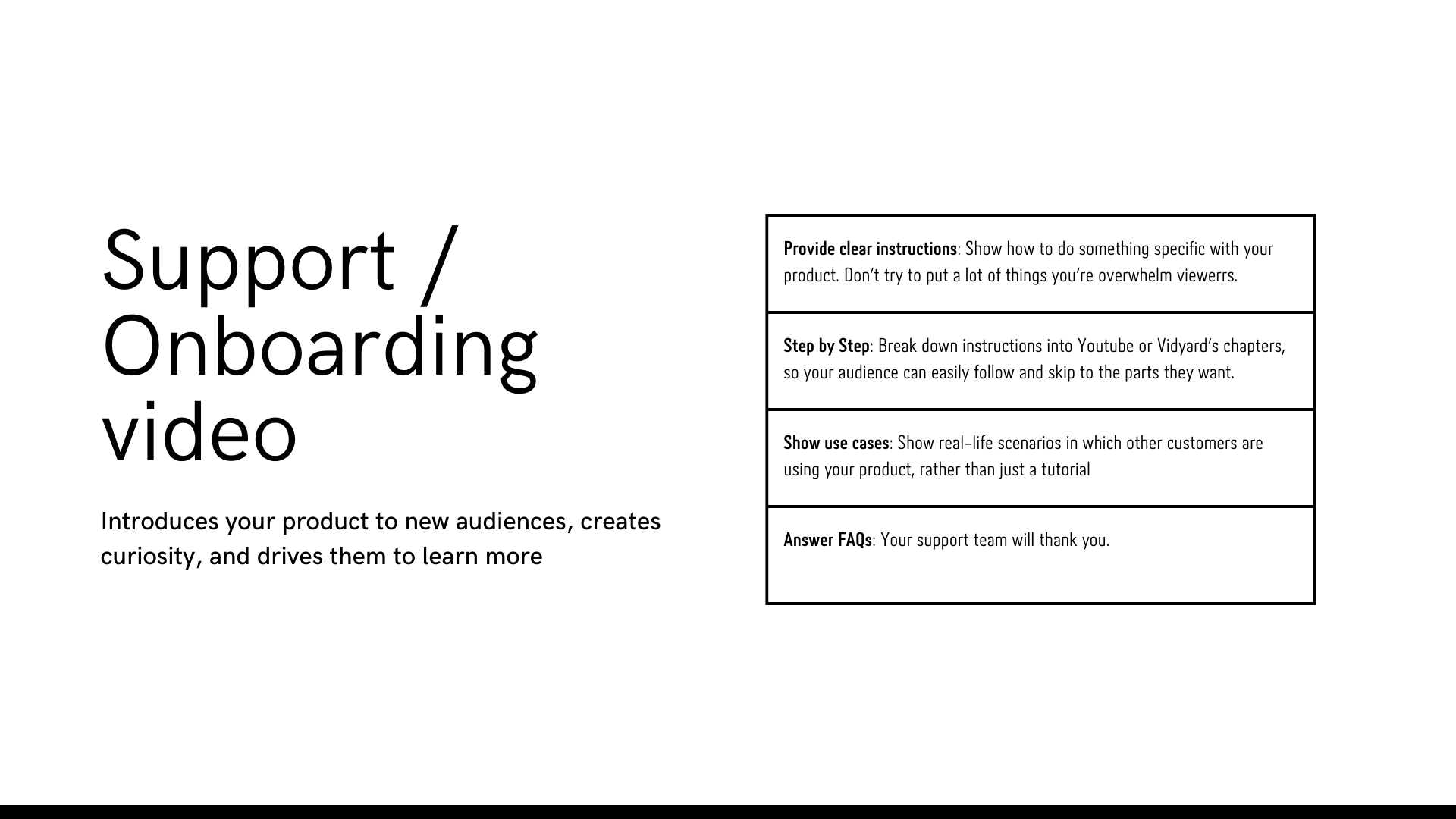
By following these best practices, you’ll create some awesome support videos and product demos that will retain your software business in 2023.
Measure and Optimize Your Video Marketing Performance
There’s many goals you can set for your videos, but the most common ones for a product launch are:
- Increase lead generation: Capture more qualified leads who are interested in your product.
- Measure this goal by tracking metrics such new leads, conversion rate (from viewer to lead), cost per lead (CPL).
- Sales Enablement: Train and support sales teams by providing them with videos that show the value of your product.
- You can measure this goal by tracking metrics such as sales opportunity generation (from lead to opportunity), pipeline influence (the amount of revenue influenced by videos), win rate (the percentage of opportunities that result in closed deals), etc.
- Drive retention in your product: You want to retain your existing customers by educating them on how to use your product and get them to the aha moment faster.
- This will take longer to measure, so keep an eye on customer satisfaction (CSAT), net promoter score (NPS), customer lifetime value (CLV), and churn rate (the percentage of customers who stop doing business with you).
Once you have a clear goal in mind, and an understanding of your buyers’ journey, then you’ll have clarity in the content you need to create.
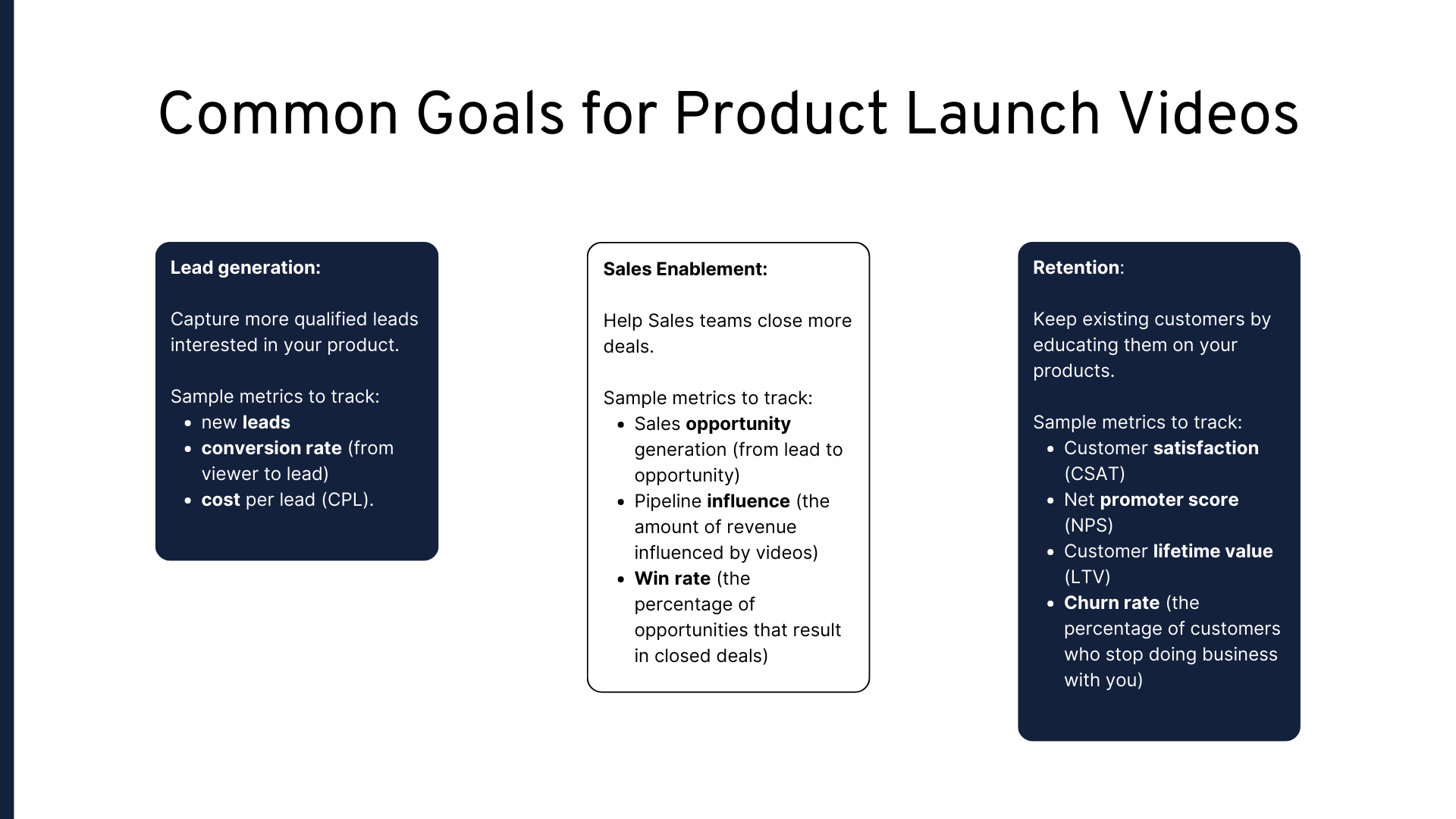
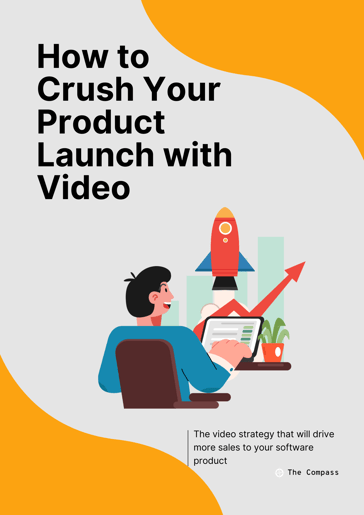
FREE Guide
If you want to have the information from this post handy, download our guide: How to Crush Your SaaS Product Launch with Video. It has all of the tips and strategies you need to create a successful launch.
Get your FREE copy
Now let's put it into practice!
Let’s create a video strategy together
Say you want to increase trial sign ups for a new version of your productivity app.
So how you get people to try it out?
The first step is to identify the audience for your videos. If you have prepped the launch collateral, you already know this.
Say for example it’s professionals who are juggling too much work, probably working as one-man bands in a startup or a new team. They go to YouTube for actionable hacks, morning routines, and they follow X,Y, Z creators.
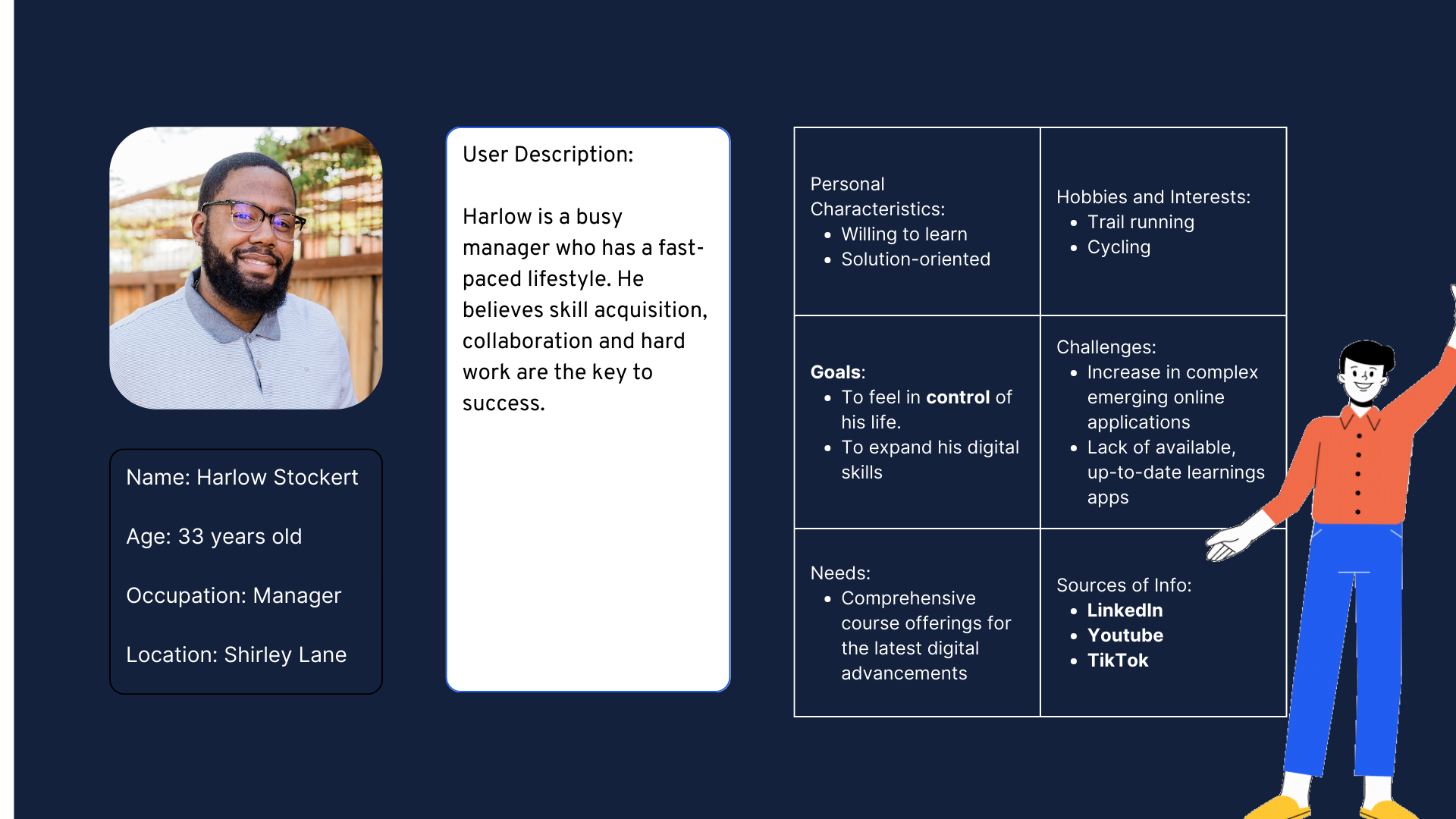
We know that some possible channels for reaching them are YouTube, TikTok, and LinkedIn.
Let’s write them down.
If this new product is going to be supported by a series of blogs, then let’s have videos there too.
If we have currently users in the product, we can even put the promo video in the product itself as a modal and redirect to the landing page.
Now we’ve covered the awareness stage. -> Social media and Blogs.
Now, people who watch those videos might be curious to see what the product is about, but they don’t want to fill out a form or book a call just yet.
That’s why we’re going to provide them with an explainer video showing why they should consider the product.
We’ll put it in the landing page.
Then we can have a testimonial of a customer from the beta stage who saw success from the product. This will help visitors trust our product even more.
You can see it all laid out in a visual form here:

This combo is a basic strategy to get people to take an action (in this case sign up for a trial), but it can also be expanded to get people to take more complex actions, like booking a call with your sales team.
The Takeaway
Video marketing is one of the most powerful ways to reach and engage your potential customers at every stage of their buyer’s journey.
By creating videos that align with their needs and preferences, you can attract more leads, educate them about your offer, persuade them to buy from you, and retain them as loyal customers.
All of which are key for a successful product launch.
Once you know the fundamental steps, then putting them together is very easy. Let’s do a quick recap of what we just covered. You’ve learned how to:
- Map your audience’s buyer’s journey
- Choose the right types of videos and channels for each stage of the journey
- The 4 types of videos to help you attract and retain clients
- Create a video marketing strategy for your launch
Now comes the fun part: planning and creating a video strategy for your product.
If you need some help, we’re here for you!
We’d love to hear more about your goals and help you design a plan to achieve them with video

Book a free strategy session today!
Crush your next product launch with a video strategy.
Thank you and see you next time!


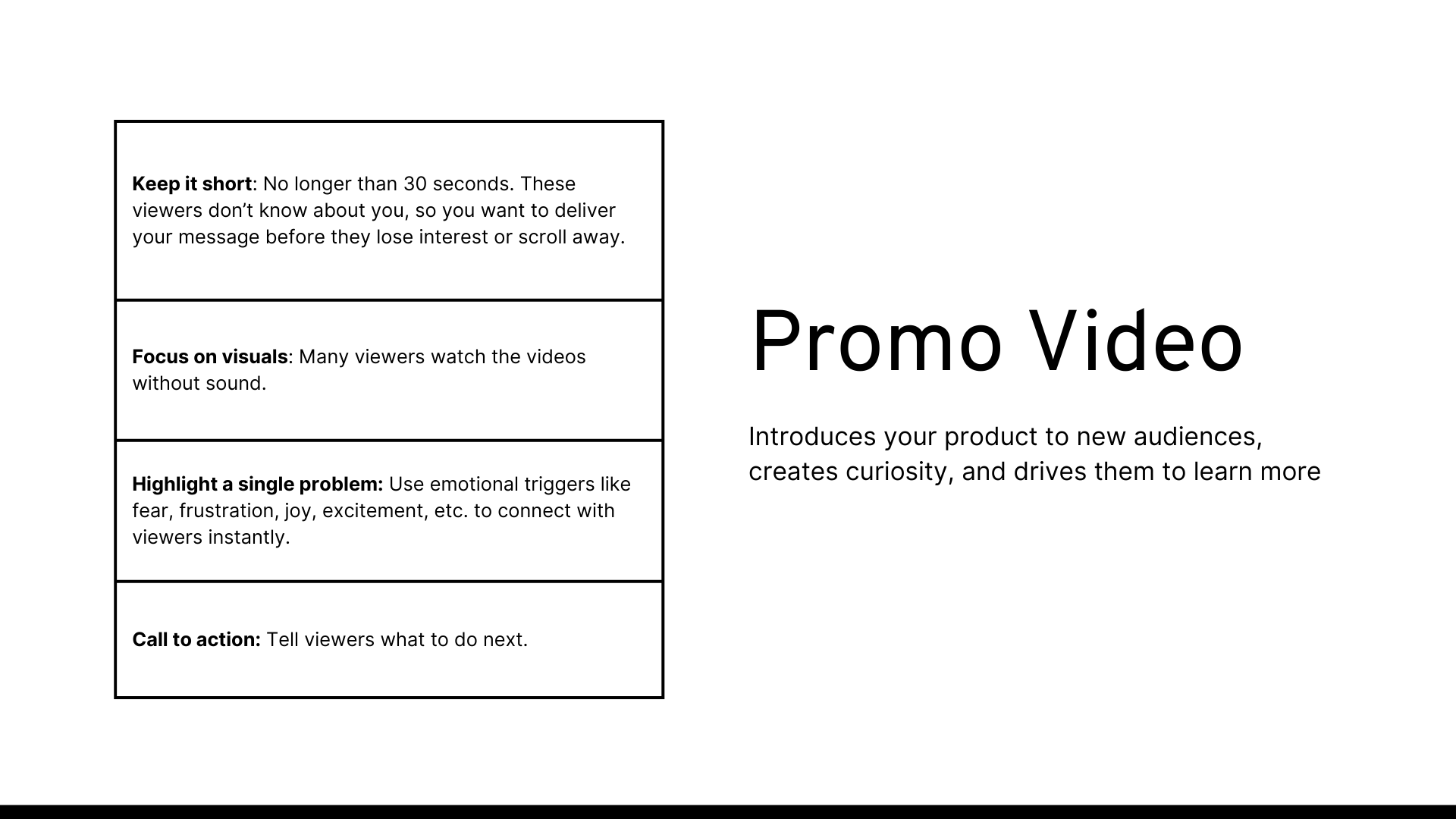
Comments